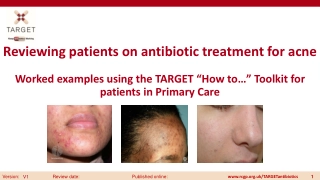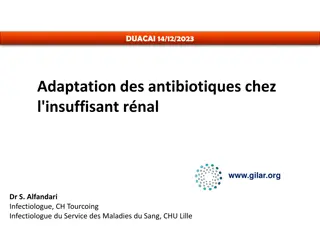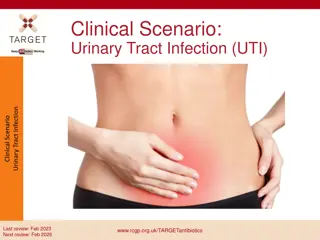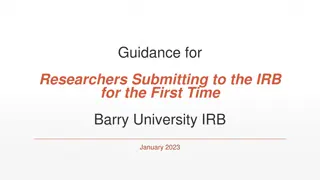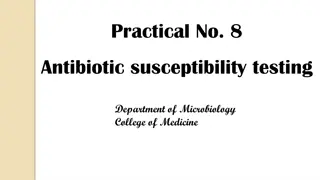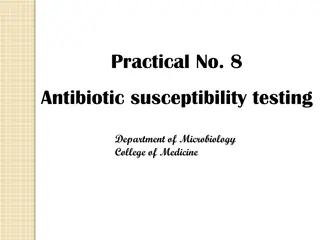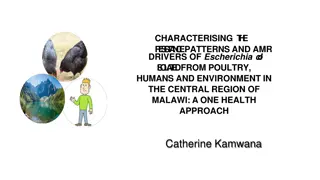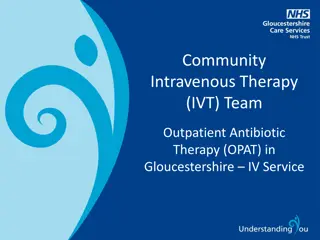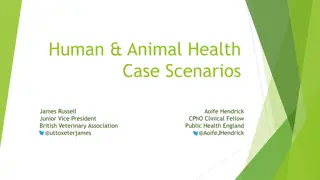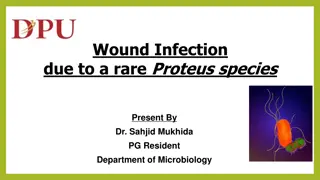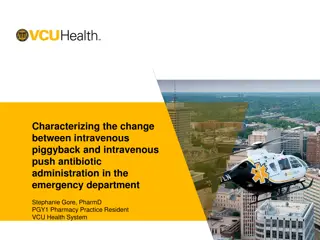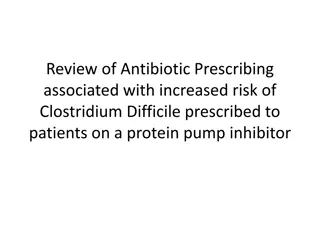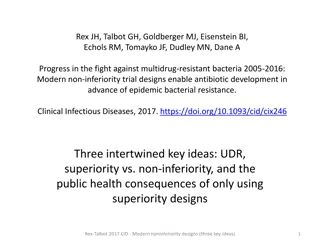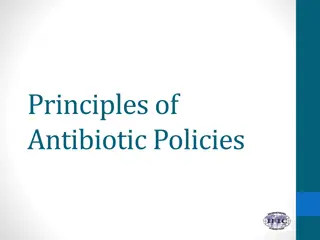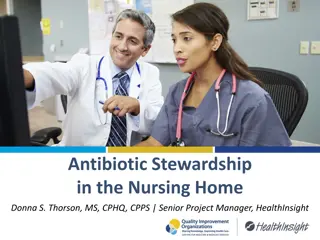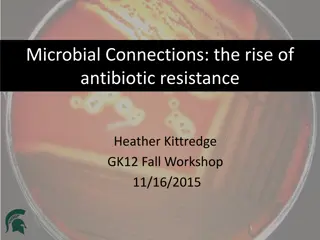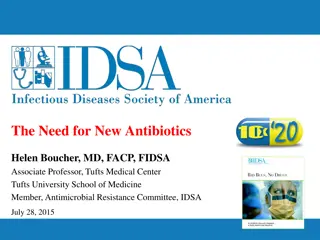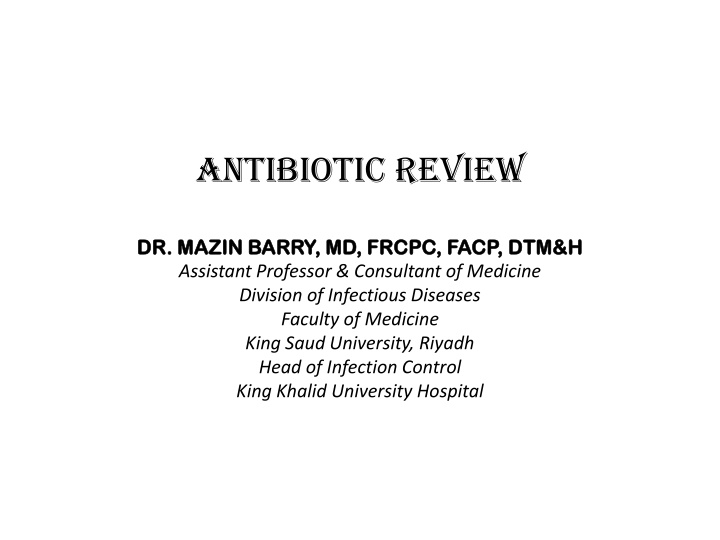
Antibiotic Use: Insights from Dr. Mazin Barry
Dive into the realm of antibiotics with valuable insights from Dr. Mazin Barry, covering general knowledge, resources, and the three key ways antibiotics are used: prophylaxis, empiric, and definitive treatments. Gain knowledge on disease states, bugs, drugs, local epidemiology, and patient-specific factors to optimize antibiotic therapy.
Download Presentation

Please find below an Image/Link to download the presentation.
The content on the website is provided AS IS for your information and personal use only. It may not be sold, licensed, or shared on other websites without obtaining consent from the author. If you encounter any issues during the download, it is possible that the publisher has removed the file from their server.
You are allowed to download the files provided on this website for personal or commercial use, subject to the condition that they are used lawfully. All files are the property of their respective owners.
The content on the website is provided AS IS for your information and personal use only. It may not be sold, licensed, or shared on other websites without obtaining consent from the author.
E N D
Presentation Transcript
ANTIBIOTIC REVIEW DR. MAZIN BARRY, MD, FRCPC, FACP, DTM&H DR. MAZIN BARRY, MD, FRCPC, FACP, DTM&H Assistant Professor & Consultant of Medicine Division of Infectious Diseases Faculty of Medicine King Saud University, Riyadh Head of Infection Control King Khalid University Hospital
GENERAL THINGS TO KNOW THINGS TO KNOW General stuff (Disease States, Bugs, Drugs) Practice - Specific - Local epidemiology (organisms & resistance trends) - Formularies, cost Patient specific - Exposure history, risk factors for specific drugs - Allergies, organ dysfunction, interacting medications, weight, height
RESOURCES BOOKS - Mandell, Douglas, and Bennett s Priciples and Practice of Infectious Disease - The Sanford Guide to Antimicrobial Therapy. HIV book also available. ARTICLES - Treatment Guidelines from the Medical Letter The Choice of Antibacterial Drugs - Mayo Clinics Proceedings series PEOPLE - Resident, attending: ID Consultation, Infection Control Personnel; Pharmacy; Micro Lab.
THREE WAYS ANTIBIOTIC USED Prophylaxis, Empiric, Definitive PROPHYLAXIS - Medical: ~ Exposure to virulent pathogen - HIV, N. meningitis ~ Immunocompromised - HIV with CD4<200, Asplenic, Neutropenic - Procedural (Surgery) Short course recommended / preferred ~ Endocarditis
THREE WAYS ANTIBIOTICS USED Prophylaxis, Empiric, Definitive (2) Empiric (usually up to 72 hours) - Diagnosis of infection made based on S/S, lab, etc. Likely pathogens suspected but specific pathogen not yet known. - Pick antibiotics based on: = Likely pathogens, local susceptibility trends, and patient-specific factors (allergies, organ dysfunction) - Pearls: = Get cultures on the front end (including special tests) = Start appropriate antibiotics ASAP.
THREE WAYS ANTIBIOTICS USED Prophylaxis, Empiric, Definitive (3) Definitive - Microbiologic or serologic diagnosis with susceptibilities known or presumed* * syphilis is susceptible to penicillin - Caveats on susceptibility testing: Interpretation of MIC or KB zone as S, I, or R is bug- drug specific (relative to concentrations of drug in body) Can t just pick the one with the lowest MIC - Some results to broad-spectrum agents maybe suppressed (cascaded reporting) Call the microbiology lab - Additional testing may be needed (KB or E-test)
THREE WAYS ANTIBIOTICS USED Prophylaxis, Empiric, Definitive (4) Definitive - Use the most effective, least toxic, narrowest spectrum, and most cost effective agent the Drug of Choice (DOC) ~ May actually be a combination of drugs - Ampicillin and Gentamicin for enterococcus endocarditis - Know the alternatives especially for patients with allergy to drug of choice. - Drug, dose, route, interval, and duration is disease state and patient specific.
How Long to Treat? Not well defined! - Usually less than 14 days! ~ Longer for endocarditis, Osteomyelitis, Prostatitis (& varies by bug & drugs) - Track number of days of therapy in progress note & set endpoint! ~ Coag Neg Staph Bacteremia: 5 7 days ~ Staph aureus Bacteremia: > 28 days (all IV) Prolonged unnecessary therapy increases risk of resistance, adverse effects, and cost!
Know Your Bugs! Gram - Positive S. aureus: - 25 50% Methicillin Resistant (MRSA) Originally in hospitals; Community Acquired strain now spreading - MSSA DOC: cloxacillin; Cefazolin - CA-MRSA: Vancomycin, Linezolid, Daptomycin ~ If uncomplicated: Trimeth/Sulfa (99%), Clindamycin (70%) Enterococcus: - DOC: (Ampicillin or Vancomycin) PLUS (Gentamicin or Streptomycin) Nitrofurantoin, Amp or Vanc alone for UTI - VRE, ARE, HLARE varies by hospital
Know Your Bugs! Gram Positive (2) S. pneumoniae: -- 20 45% have decreased susceptibility to penicillin. ~ = Highest in children (especially daycare, socioeconomic) = Example: Susceptible Intermediate Resistant Penicillin 51% 40% 9% Ceftriaxone 92% 9% (6@MIC 1) 0% Moxifloxacin 98% 2% 0% ~ CNS Infections: = High dose (HD) Ceftriaxone (2g IV Q 12h) + HD Vanco ~ Outside CNS: = Ceftriaxone; Respiratory FQ if at risk for resistance = High dose amoxicillin = +/- Doxycycline, TMP / SMX, Erythromycin
Know Your Bugs! Gram Negative E. coli ~ 50% resistant to Ampicillin, Amp / Sulbactam ~ 25% resistant to Trimeth / Sulfa ~ 33% resistant to Ciprofloxacin P. aeruginosa ~ Best Drugs (> 90% susceptible) = Ceftazidime, Cefepime, Piperacillin (with or w/o Tazo) = PLUS an Amikacin for synergy ~ Less effective (80-90% susceptible) = Tobramycin, Gentamicin ~ If C & S verifies susceptibility (65 80% susceptible) = Imipenem, Meropenem, Aztreonam, Ciprofloxacin
Know Your Bugs! Gram Negative (2) Bad nosocomial Gram Negative ~ Acinetobacter baumanii = Doc Colistin* with meropenem (bleaching effect) +/- Amikacin * Alternative is tigecycline ~ Stenotrophomonas maltophilia (resistant to Imipenem) = DOC Trimethoprin/Sulfamethoxazole (Bactrim) = 10 mg/kg/day of TMP components (2Ds tablets Q12h) Most ICUs have their own flora & susceptibility patterns. Patients become colonized within 48-72 hrs with these bugs
Know Your Bugs! Other Bacteria Anaerobes Peptostreptococcus, Clostridium, & Bacteroides - Overall: Amox/Clav, Amp/Sulb, Ticar/Clav, Pip/Tazo, Meropenem, Imipenem, and Tigecycline - Mouth & Lungs: Clindamycin - Abdomen: Metronidazole Atypical Legionella, Mycoplasma, Chlamydia - Macrolides, Tetracycline, Respiratory fluoroquinolones
Know Your Bugs! By Mechanism of Action Cell Wall ~ Penicillin Binding Proteins (PBP): Beta-Lactams = Penicillins +/- beta-lactamase inhibitors = Cephalosporins = Others (imipenem, aztreonam) ~ Percursor molecules: Vancomycin Intracellular ~ Ribosomes: Macrolides (5OS), Tetracycline (30S), Aminoglycosides (30S & 50S) ~ DNA gyrase: Quinolones ~ Folate metabolism: Trimethoprim, Sulfa s
Know Your Bugs! Mechanism of Resistance Altered target PBP s. ~ Absolute Change = no binding = MRSA is resistant to all beta-lactams et al ~ Relative Change = binding, MIC = Drug resistant S. pneumoniae Enzymes destroy Beta-lactamases ~ Penicillinase: MSSA, H. influenzae, anaerobes = Add beta lactamase inhibitor or change structure ~ Cephalosporinase: Enterobacter et al ~ Extended Spectrum Beta Lactamase (ESBL): Kleb Pneumo, E. coli
Penicillins Penicillin PO, IV & IM = GP (Strep) Amoxicillin PO, Ampicillin IV = GP (Strep), some GNR (70% H. influenzae) Cloxacillin PO, IV = GP (MSSA) Amoxicillin / clavulanate (AUGMENTIN) PO, IV = GP (MSSA, GNR, Anaerobes) Piperacillin / Tazobactam (Tazocin) IV = GP (MSSA), GNR (> 90% PA), Anaerobes
GP GN Ana DOC Penicillin Strep None Some Syphilis, Strep Ampicillin Amoxicillin Strep Some Some Enterococcus. Listeria cloxacillin MSSA None None MS SA Amox / clav Strep Some; Great Mixed Community H. Influenzae Pip / Tazo Strep MSSA H. influ. Pa et al Great Mixed Nosocomial
Cephalosporins & Other Beta-Lactams Aztreonam Cephalexin PO Cefazolin IV - Beta-Lactam allergy - GP (MSSA), GNR Cefuroxime - GNR (80% PA) Ceftriaxone IV, IM Imipenem/cilastatin - GP (S. pneumo), Meropenem -GNR - GP (including MSSA) Ceftazidime IV - GNR (> 85% PA) - Anaerobes Cefepime IV - GP (S. pneumo) - GNR (>90% PA) Ceftaroline IV GP (MRSA) GNR (NOT PA, ESBL) - 95% GNR
GP GN Ana DOC Strep MSSA E.Coli None SPPLX SSTI Cefazolin Strep E.coli, Kleb None CAP Ceftriaxone S. Pneiumo Meningitis Poor E coli, Kleb, PA None HAP et al Ceftazidime Strep MSSA Ecoli, Kleb, PA None HAP et al Nosocomial Cefepime Strep MSSA Most including ESBL Great Mixed Nosocomial Imipenem Meropenem None Most GNB (No activity against: serratia, proteus, burkholderia, moraxella, providencia, morganella) None KPC, PDR PA, acinetobacter Colsitin
Beta-Lactam Adverse Effects Allergic / Hypersensitivity in 3 10% of pts. = Rash (4-8%) to anaphylaxis (0.01-0.05%, 10-20 minutes) ~ Carbapenems: 5% cross reactive, Cephs 10% ~ Vasculitis, Cytopenias, Fever, Interstitial Nephritis N/V with PO Seizures w/ high dose in renal insufficiency Ceftriaxone: Biliary sludging and bilirubin displacement (don t use in neonates)
VANCOMYCIN Exclusively Gram-Positive Spectrum, IV only* Last Line of Defense - Methicillin Resistant Staph - Ampicillin Resistant Enterococcus - Multi-drug Resistant S. pneumonia - 2ndline for C. difficile Colitis (*only indication for PO Vanco) IV only, Check levels & adjust frequency for renal impairment Troughs = 10 20 (15-20 for pneumonia et al) Peaks = 20-40 (higher in pneumonia et al) ?Clinical Utility? 15 20 mg/kg/dose (1g) IV Q8 12h (Q24h+ for CICr < 60) - Call pharmacy for help with dosing.
QUINOLONES Ciprofloxacin - GNR (75% PA) Levofloxacin, Moxifloxacin - GP (S. pneumo), GNR (respiratory; PA 70% w/ Levo) Cl in pregnancy & children - Rash/photosensitivity, Chelates (PO), CNS side effects, Tendon Rupture QTc prologation, Hypo/Hyperglycemia
AMINOGLYCOSIDES (all IV or IM) Gentamicin, Tobramycin GNR (Tobra > Gent vs. P. aeruginosa) Amikacin, Streptomycin - TB, Multi-drug Resistant GNR Renal elimination, variable penetration in to tissue CNS < 5%, Lungs 50%, Urine 10 100 X Dosing: - Pick dose based on site/bug and interval per renal function (GFR < 60). - Once Daily for select patients only GNR; good renal function). Nephrotoxicity (non-oliguric) & Ototoxic Prolonged exposure to elevated levels (troughs >2).
Macrolides & Lincosamides Erythromycin GP (Strep) & Atypicals GI side effects and inhibits CYP450 = drug interactions Azithromycin IV, PO Clarithromycin PO - GP (Strep), Atypicals & Respiratory GNR; Mycobacterium Clindamycin (all PO, IV) - GP (GP 75% MRSA), Anaerobes - C. difficile colitis
Other Antibacterials Tetracycline PO, Doycyclne PO & IV - GP, GN, Atypicals; Brucella - Binds orally with calcium deposits on teeth, photosensitivity Trimethoprim / Sulfamethoxazole - GP (98% MSSA & MRSA), 80% GNR - Rash and other ADE s, Drug interactions with warfarin Metronidazole - Anaerobes & Protozoa - Reactions with EthOH, Metallic taste, drug interactions with warfarin Nitrofurantoin - UTI (including VRE) - Contraindicated at GFR < 60
Know your Drugs! Get an ID consult for: - Linezolid MRSA, VRE lungs; bacterostatic - Daptomycin MRSA, VRE; endocarditis, not lungs - Tigecycline, Colistin PDR Acinetobacter baumanii
Antiviral Antiviral Antivirals - HSV: Acyclovir, Valacyclovir; Famiclovir - CMV: Ganciclovir, Valgancyclovir; Foscarnet - Influenza: Oseltamivir (Tamiflu), Zanamivir; Amantadine Infection Drugs Adult Dosage Cost Hepatitis B Virus (HBV) Chronic Hepatitis Lamivudine- Epivir HBV Interferon alta 2b-Intron A Peginterferon alta 2a-Pegasys Acelovir - Heparia 10 mg PO 1X $2,452.80 7,292.40 18,712.80 8,486.05 Hepatitis C Virus (HCV) Chonic Hepatitis Peginterferon alfa-20 PEG lotion plus tavirin generic Coaguia Bocepravir Telapravir 1.5 mcgkg once/wk SC x 48 weeks 800-1200mg PO/d x 48 wks 180 mcg once/wk SC x 48 wks 800-1200 mg PO/d x 48 wks 19,043.04 9,852.16 13,749.12 18,712.80 9,932.16 9,354.24 Acute Hepatitis Interferon alfa 2b 5 million___x 3 wks Then 3d/wk x 20 wks 1,875.32 4,888.30
Antifungals Binds Ergosterol (makes cell walls leak) Amphotericin B - Life Threatening systemic mycosis Inhibit cell wall synthesis (Beta 1, 3 D glucan) - Echinocandins (Anidulafungin, Caspofungin, Micafungin) - Candida (including azole R sps.)
Azoles Inhibit Ergosterol Biosynthesis Fluconazole Candida albicans, Crypto Itraconazole PO; Histo, Blasto, Aspergillus Voriconazole Aspergillus et al Posiconazole PO Zygomycosis Ketoconazole, Miconazole, & Clotrimazole topical/dermatophytes Table I Azoles Drug Usual Dosage Cost Parenteral Fluconazole- 100-800 mg 1x/d $357.62 Voriconazole 4 mg/kg bid 364.89 Oral Fluconazole- 100-800 mg 1 x/d 57.20 71.15 Itraconazole 200 mg 1 x /d bid 43.75 Posaconazole 100 mg 1 x/d-200 mg qid 145.80 Isavuconazole : Voriconazole 200-300 mg bid invasive aspergillosis and mucormycosis 116.97
Know your Drugs! Pharmacodynamics Pharmacodynamics (PD) - Bacteriostatic: Inhibit ~ Generally avoid for endocarditis, meningitis, osteomyelitis, and febrile neutropenia ~ Tetracyclines, Macrolides, TMP / SMX, Linezolid - Bacteriocidal: Kill ~ Dose dependent (Peak:MIC > 10) - Aminoglycosides, Quinolones ~ Exposure dependent (T >MIC) - Beta lactams, vancomycin ~ May require a combination of drugs (e.g., enterococci)
Know your Drugs! Absorption: IV vs PO - Great PO absorption with fluconazole, fluoroquinolones (watch drug interactions), Metronidazole, TMP/SMX, doxycycline. - IV only: ~ Vancomycin (except for C. difficile) ~ All antipseudomonal agents except ciprofloxacin ~ 3rdand 4thgeneration cephalosporins (may give IM) ~ Meropenem, Imipenem, ertapenem (IM available) and Aztreonam ~ Aminoglycosides (gentamicin et al) - may give small dose IM
Know Your Drugs! DISTRIBUTION CNS Penetration: - Excellent: Metronidazole, chloramphenicol, fluconazole, TB drugs - Adequate with high doses: Ceftriaxone, ceftazidime, ampicillin - Problematic: Vanconmycin, aminoglycosides - Lungs: - Good: quinolones, Macrolides, beta-lactams - Modest: aminoglycosides
Know Your Drugs! Metabolism / Elimination - Kidneys - Adjust for renal dysfunction (Cl Cr) - May use lower doses for UTI - Liver - Adjust for liver dysfunction (???) - Potential for drug interactions
Dosing in Renal Dysfunction (140 Age) X ibw / 72 X S. Cr. - Multiply result by 0.85 if patient female - Round S. Cr. Up (0.8?) if <1 and elderly Cl Cr <60 adjust interval +/- dose of: - Penicillins (not Nafcillin, Oxacillin) - Cephalosporins (not Ceftriaxone) - Imipenem else 10 X risk seizures - Aztreonam - Vancomycin - Aminoglycosides
Dosing in Renal Dysfunction Misc agents - TMP / SMX (and generally avoid) - Fluconazole - Acyclovir - Ganciclovir - Most nucleoside RTI s Avoid (nephrotoxic) - Amphotericin B (lipid forms less toxic)
Dosing in Hepatic Dysfunction Note also generally don t need to be adjusted for renal dysfunction. - Ceftriaxone, Nafcillin - Clindamycin, Metronidazole - Macrolides, Tetracyclines - Rifampin, Isoniazid
Drug Interactions! Drugs cleared by CYP 450 Statins, Cyclosporine, Benzodiazepines, Theophylline, Anticonvulsants, oral hypoglycemic - Levels increase by (Metabolism inhibited by) Macrolides (Erythromycin) Azoles (Fluconazole, Itraconazole) Protease inhibitors Ciprofloxacin - Levels decreased by (Metabolism induced by) Rifampicin, rifabutin Oral Contraceptives - Decreased with rifampin & nafcillin +/- others
Drug Interactions! Warfarin: - Effect & INR profoundly increased by trimethoprim/sulfamethoxazole metronidazole - Significant increase with fluconazole, +/- Ciprofloxacin - Decreased by Rifampicin/rifabutin Multivalent Cations (Ca, Mag, Iron) +/- TF - Decreases absorption of: Fluroquinolones Tetracyclines
Adverse Effects Allergies (NEJM 2006; 354-601-9) Penicillin Allergy: - Fully cross- reactive with other penicillins - May cross-react with cephalosporins 10% to 1stgeneration, 1 2% to3rd - Not cross reactive with aztreonam. Sulfa Allergy: - other sulfonamides (including diuretics) - not sulfites, sulfates; +/- sulfones
Adverse Effects Other Antibiotics generally safe but . - Rash: almost any of them - Diarrhea, C. difficile colitis: most of them - Nephrotoxicity: Aminoglycosides, amphotericin - Photosensitivity: fluoroquinolones, tetracyclines - Relatively contraindicates in pregnancy: Aminoglycosides, fluoroquinlones, tetracycline, fluconazole, ribavirin et al..
Preventing the Use of Antibiotics Verify diagnosis & need for antibiotics - Consider other (non-infections) causes of symptoms - Remember: antibiotics don t work against viruses Vaccinate at risk patients - Children, elderly, immunocompromised, healthcare professionals. WASH YOUR HANDS! - Also stethoscopes
ANTIBACTERIAL AND ANTIFUNGAL PHARMACODYNAMIC CHARACTERISTICS Class Mechanism of Action Concentration vs Time Dependent Activity Bactericidal vs Bacteriostatic Activity Mechanisms of Resistance Antibacterial Agents B-Lactams Altered PBP (MRSA, PRSP) B-Lactamase production (PPNG; TEM and SHV-producing organisms; ESBL- producing K. pneumonia and E. coli; AmpC gene induction in Enterobacter, Citrobacter, Morganella, Providentia, Serratia, and Pseudomonas species) Penicillins Inhibition of PBP activity resulting in peptidoglycan layer synthesis in cell wall Time Cidal Cephalosporins (e.g., cefazolin) Time Cidal Loss of outer membrane porin channels for entry (Pseudomonas aeruginosa) Carbapenems (e.g., imipenem) Time Cidal Ionic interaction with cell wall Disruption of protein synthesis of 30S ribosomal subunit via codon misreading Production of aminoglycosides modifying enzymes (acetylases, adenylases, phosphorylases) resulting in drug inactivation 30S ribosomal mutation Decreased membrane permeability Aminoglycosides (e.g., gentamcin) Conc Cidal Altered binding site due to mutation in DNA gyrase and/or topoisomerase IV Active efflux pump Fluoroquinolones (e.g., ciprofloxacin) Inhibition of DNA gyrase and topoisomerase IV activity Conc Cidal
ANTIBACTERIAL AND ANTIFUNGAL CHARACTERISTICS (CONT D) ANTIFUNGAL PHARMACODYNAMIC Bactericidal vs Bacteriostati c Activity* Concentration vs. Time Dependent Activity Class Mechanism of Action Mechanisms of Resistance Ligase conversion of D-ALA-D-ALA to D-ALA-D lactate which prevents vancomycin binding Glycopeptides (e.g., vancomycin) Binding to D-ALA-D-ALA terminus complex in peptidoglycan layer of cell wall to inhibit PBP binding & activity Time Cidal 23S Ribosomal subunit methylation by erm gene products Active efflux (e.g., efflux pump from msr gene inducton in S. aureus or from mef induction in S. pneumonia or S. pyogenes) Macrolide modification or inactivation Macrolides (e.g., erythromycin) Binding to 50S ribosomal subunit and interruption of protein synthesis via transpeptidation or translocation inhibition Time Static (Azithromycin Conc) Nitroimidazoles e.g., metronidazole Toic free radical formation Conc Cidal Unclear / uncommon Oxazolidinones (e.g., linezolid) Disruption of protein synthesis at 30S/50S ribosomal subunits Time Static (cidal to streptococci) Ribosomal binding site alteration Streptogramins (e.g., quinupristin/ Dalfopristin) Binding to 50S subunit of ribosome resulting in inhibition of peptide chain elongation and peptidyl transferase activity; quinupristin and dalfopristinare synergistic Time Cidal (staphylococci, streptococci, Enterococcus faecium) 23S Ribosomal subunit methylation by erm gene products (MLSB resistance) Active efflux Enzyme inactivation Static (Enterococcus faecalis)
ANTIBACTERIAL AND ANTIFUNGAL PHARMACODYNAMIC ANTIBACTERIAL AND ANTIFUNGAL PHARMACODYNAMIC CHARACTERISTICS (CONT D) CHARACTERISTICS (CONT D) Concentration vs. Time Dependent Activity Bactericidal vs Bacteriostatic Activity* Class Mechanism of Action Mechanisms of Resistance Lincomycins (e.g., clindamycin Disruption of protein synthesis at 50S ribosomal subunit via inhibition of amino acid linking Time Static 23S ribosomal mutation/methylation (MLSB resistance) Rifamycins (e.g., rifampin Binding interference at 30S ribosomal subunit / mRNA complex binding interference Time Static Single step mutation in - subunit of DNA-dependent RNA polymerase (e.g., S. aureus) Tetracyclines Binding to 30S ribosomal subunit and disruption of protein synthesis at 50S subunit via inhibition of amino acid linking Conc Static Decreased uptake Active efflux pump Disruption of folate synthesis; DNA synthesis Sulfa (e.g., sulfamethoxazole/trim ethoprim Conc Static Production of new dihydrofolate reductase and dihydropteroate synthetase PABA Decreased membrane permeability Antifungal Agents Uncommon Decreased ergosterol cell membrane content (e.g., via previous azole use) Polyenes (e.g., amphotericin B) Disruption of cell membrane via intercalation with sterols, disrupting cell integrity Cidal * Nature of activity at recommended doses against usual pathogens
ANTIBACTERIAL AND ANTIFUNGAL PHARMACODYNAMIC ANTIBACTERIAL AND ANTIFUNGAL PHARMACODYNAMIC CHARACTERISTICS (CONT D) CHARACTERISTICS (CONT D) Concentration vs. Time Dependent Activity Bactericidal vs Bacteriostatic Activity* Mechanisms of Resistance Class Mechanism of Action Modification of cytochrome P450- dependent 14a- demethylase Active efflux pumps Azoles (e.g., fluconazole) Disruption of fungal sterol synthesis via inhibition of cytochrome P450- dependent 14a- demethylase which is required for conversion of lanosterol to ergosterol Static Common, especially if agent used alone 5-Flucytosine Cellular conversion to 5- fluorouracil, a false pyrimidine, and subsequent interference with DNA and protein synthesis Inhibition of -1, 3- glucan synthetase resulting in disruption of cell membrane synthesis Cidal Unknown Echinocandins (e.g., caspofungin) Cidal (Candida species) PBP = penicillin-binding proteins MRSA = methicillin-resistant Staphylococcus aureus PRSP = penicillin-resistant Streptococcus pneumonia PPNG = penicillin-producing Neisseria gonorrhoeae ESBL = extended-spectrum -lactamase D-ALA = D-alanine PABA = para-aminobenzoic acid
Acute Otitis Media (AOM) Dx: bulging TM, or new otorrhea Pathogen: No pathogen (4%) Virus (70%) Bacteria + virus (66%) Bacteria (92%) Strept. Pneumo (49%) H. Influenzae (29%) Moraxella catarrhalis (28%)
AOM Need to know prior antibiotic use and local susceptibilities for S. pneumonia Amoxocillin, Amoxocillin/clavulinate, cefpodoxime, moxifluxacin (10 days) Failure to respond in children: tympanocentesis
Malignant Otitis Externa Sever ear pain, swelling, fever unusual, high ESR Bony involvement common, can progress to OM of base of skull and TM joint (do CT and treat 6 weeks with surgical debridement) RF: Elderly, DM, AIDS, chemotherapy Usually Pseudomonas aeruginosa (95%) Imipenem or Meropenem Ceftazidime or Cefepime Piperacillin (+/- tazobactam) and tobramycin Ciprofloxacin - PO if mild / early, check susceptibilities
Tonsillitis, pharyngitis Streptococcus sp. (Group A, C, G) Viral: EBV, CMV C. diphtheria Arcanobacterium haemolyticum (rare) Mycoplasma pneumonia (with cough) Fusobacterium necrophorum STD: primary HIV, HSV, N. gonorrhea, rarely secondary syphilis
Tonsillitis, pharyngitis Focus on group A strept. (GAS) (10%) Decrease symptoms, prevent suppurative complications, decrease contagion, eradicate GAS to prevent acute rheumatic fever Dx: symptom score above 1 (1 point each for): History of fever, absence of cough, tender cervical LN, tonsillar exudate NOT GAS: rhinitis, hoarseness, cough then Rapid strep Ag test Rx: Penicillin V 500mh bid for 10 days, cefuroxime if allergic Can use clindamycin, azithromycin but resistance reported


